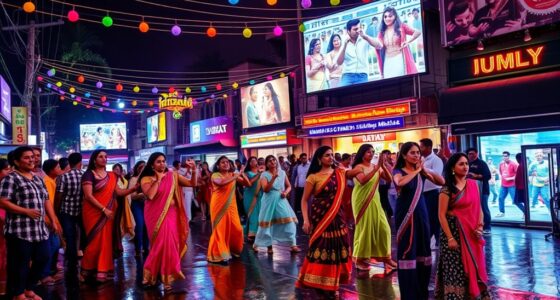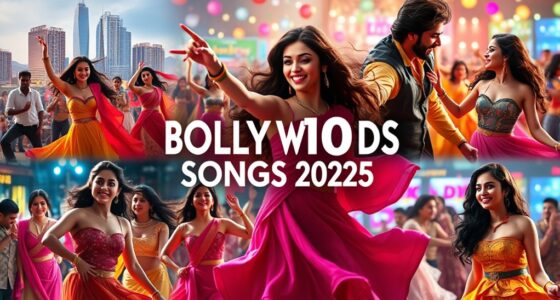If you’re curious about Bollywood’s greatest music directors, you’ll find legends like A.R. Rahman, R.D. Burman, Shankar-Jaikishan, S.D. Burman, and O.P. Nayyar, whose iconic hits have shaped Indian cinema. Their innovative fusion of classical, folk, Western, and orchestral sounds continues to inspire new generations. Understanding their unique styles and collaborations helps you appreciate Bollywood’s rich musical legacy. Keep exploring further, and you’ll uncover even more timeless melodies that define Hindi cinema.
Key Takeaways
- The article highlights top Bollywood music directors like A.R. Rahman, R.D. Burman, and Shankar-Jaikishan, noting their signature styles and iconic hits.
- It discusses their innovative fusion of classical, folk, Western, and modern sounds that shaped Bollywood’s musical landscape.
- The piece emphasizes legendary collaborations between composers and playback singers, producing timeless melodies.
- It showcases how these directors’ rhythmic styles and genre blending created memorable, danceable, and emotionally resonant songs.
- Recognitions such as awards and honors underscore their enduring influence and contributions to Indian cinematic music.
A.R. Rahman’s Fusion of Classical and Contemporary Sounds
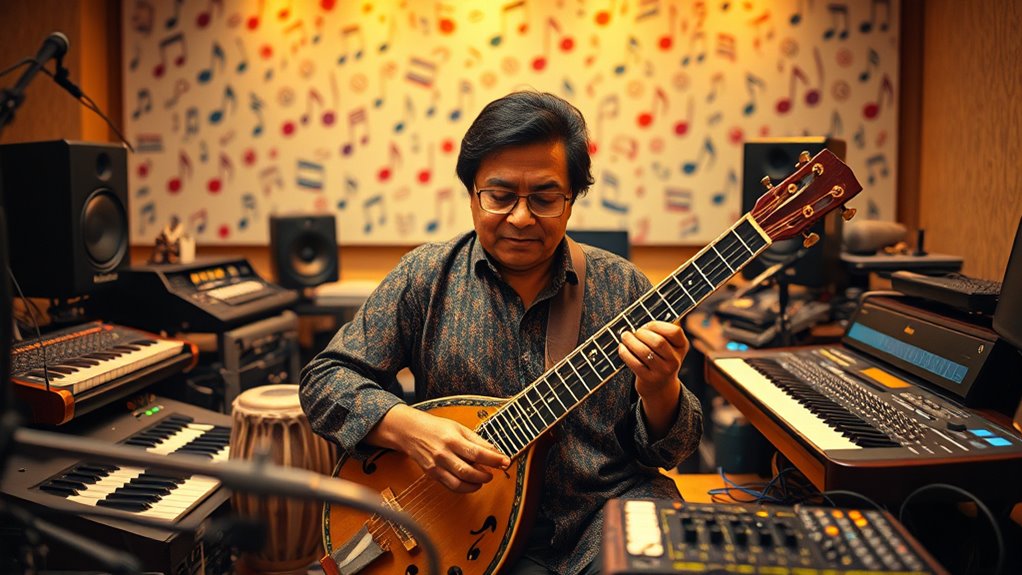
A.R. Rahman masterfully blends classical Indian melodies with modern beats, creating a distinctive fusion that resonates globally. You’ll notice how he combines Carnatic, Hindustani, and folk traditions with electronic and orchestral arrangements, adding fresh textures to Indian cinema. His debut album *Roja* introduced these innovative soundscapes, setting new standards in Indian music. Rahman also draws on Sufi, qawwali, and world music influences, broadening his appeal beyond borders. His compositions evoke deep spirituality and human emotion, connecting with diverse audiences. Tracks like “Jai Ho” and “Chaiyya Chaiyya” exemplify his ability to merge traditional motifs with contemporary sounds. Through this fusion, Rahman not only revitalizes Indian music but also elevates it onto the global stage. His innovative use of technology has further transformed how Indian music is produced and appreciated worldwide, showcasing his mastery of music production techniques.
R.D. Burman’s Experimentation With Western Instruments and Styles
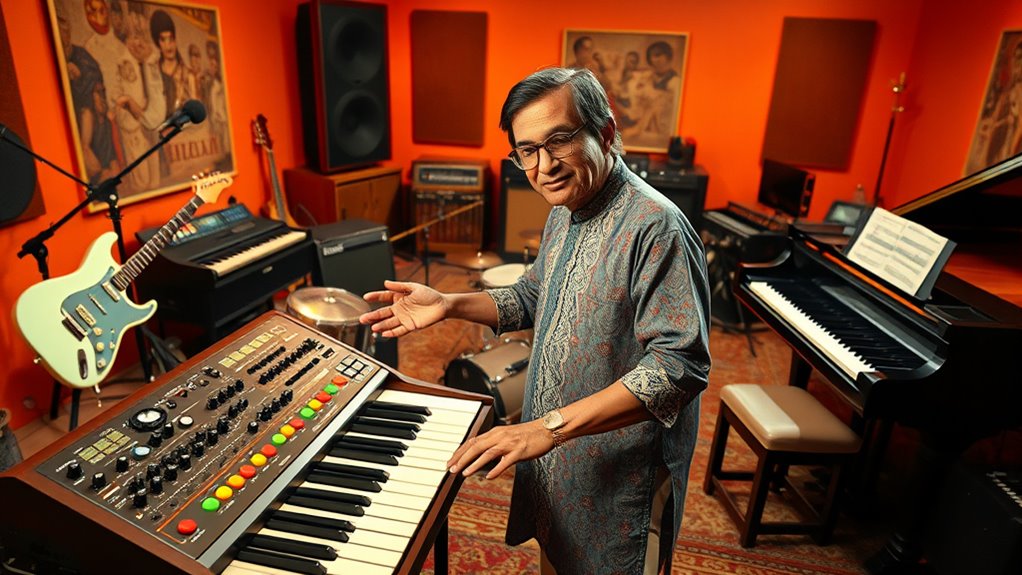
R.D. Burman revolutionized Bollywood music by experimenting boldly with Western instruments and styles. You’ll notice his incorporation of guitars, synthesizers, and electronic sounds, blending folk, disco, funk, and reggae into Indian melodies. His innovative soundscapes often featured unusual instruments, creating fresh auditory experiences. Inspired by Western icons like The Beatles and Quincy Jones, he brought a global sensibility to Indian film music. His percussion techniques also broke new ground—using unconventional instruments and rhythms, such as in “Aaja Aaja” from *Teesri Manzil*, which highlighted drum-heavy arrangements. Burman’s inventive recording methods, like using everyday objects for unique sounds, pushed technological boundaries. His timeless hits, like those from *Teesri Manzil* and *Golmaal*, showcase his mastery in fusing Western influence with Indian tradition, leaving a lasting legacy. Additionally, his musical experimentation with electronic sounds and innovative recording techniques significantly expanded the sonic palette of Bollywood music. His use of Western instruments not only enriched his compositions but also inspired many future music directors to explore cross-cultural musical fusion. Exploring unique recording techniques, Burman often crafted sounds that were unprecedented in Indian cinema, further cementing his status as a pioneer. His openness to incorporating diverse styles made his work a musical revolution that continues to influence composers today. Moreover, his ability to adapt Western musical elements while maintaining Indian melodies demonstrated a profound cultural fusion that resonated with audiences worldwide.
The Orchestral Masterpieces of Shankar-Jaikishan

You’ll notice how Shankar-Jaikishan crafted orchestral arrangements that transformed Bollywood music, blending Indian ragas with Western instruments. Their innovations include intricate layering, counter melodies, and mood-setting preludes that deepen emotional impact. These masterpieces set new standards, showcasing their mastery in musical fusion and orchestration. Their integration of classical Indian music with Western orchestration, along with their pioneering use of structured song formats, helped elevate Bollywood soundtracks to a new artistic level.
Orchestral Arrangements
Shankar-Jaikishan revolutionized Bollywood music by pioneering the use of full orchestral arrangements that transformed film songs into rich, cinematic soundscapes. They elevated the orchestra from background filler to an expressive core, using dozens to hundreds of instruments, blending Western and Indian sounds. Their layered compositions included preludes, interludes, counter-melodies, and epilogues, creating complex musical narratives that heightened emotional and dramatic effects. Strings, piano, and guitar took center stage alongside classical Indian percussion like tabla and dholak, often woven into intricate rhythmic textures. Their innovative fusion of Western harmonies and Indian melodies set new standards, making their songs both timeless and globally appealing. This approach shaped Bollywood’s musical landscape, influencing countless composers and elevating film music to a new artistic level. Their groundbreaking techniques also inspired future generations of composers to experiment with orchestration and arrangement styles in Indian cinema, fostering a rich tradition of orchestral arrangements that continue to influence the industry today. Moreover, their mastery in orchestration contributed to the sophistication of film music, elevating it to a form of high art that resonates with diverse audiences across generations. Additionally, their ability to seamlessly integrate Indian classical elements into orchestral settings enhanced the musical complexity of Bollywood compositions, setting a benchmark for excellence. Their innovative use of recording techniques further expanded the textural depth of their compositions, enriching the overall listening experience.
Raga Incorporations
- Evoking deep emotion through classical instruments such as sitar, tabla, and flute enhances the expressive quality of their compositions. Additionally, their mastery in utilizing sound recording techniques ensures that these traditional sounds are captured with clarity and depth.
- Blending Indian ragas with Western rhythms showcases their innovative approach to musical fusion, appealing to diverse audiences.
- Popularizing classical music via film soundtracks has helped preserve and promote traditional melodies.
- Creating timeless melodies rooted in tradition, they have set standards for generations of composers.
- Their innovative use of ragas in film compositions helped bridge classical and popular music, making classical music accessible and appealing to a wider audience.
Musical Innovations
The orchestral innovations of Shankar-Jaikishan transformed Bollywood music by establishing a new standard for song structure and emotional expression. You’ll notice how they used orchestras not just as background but as core expressive tools, creating rich textures with multiple instruments. Their songs follow a clear framework: prelude, mukhda, interludes, and epilogue, each enhanced with unique orchestral interludes that deepen the mood. They fused Indian classical elements with Western orchestration, blending traditional instruments with modern harmonies to craft a hybrid sound that broadened musical horizons. Their layered compositions feature counter melodies and sophisticated arrangements, making each song multi-dimensional. This innovative approach elevated Bollywood music, turning songs into storytelling devices and setting a timeless standard for emotional depth and musical grandeur.
S.D. Burman’s Folk and Minimalist Melodies
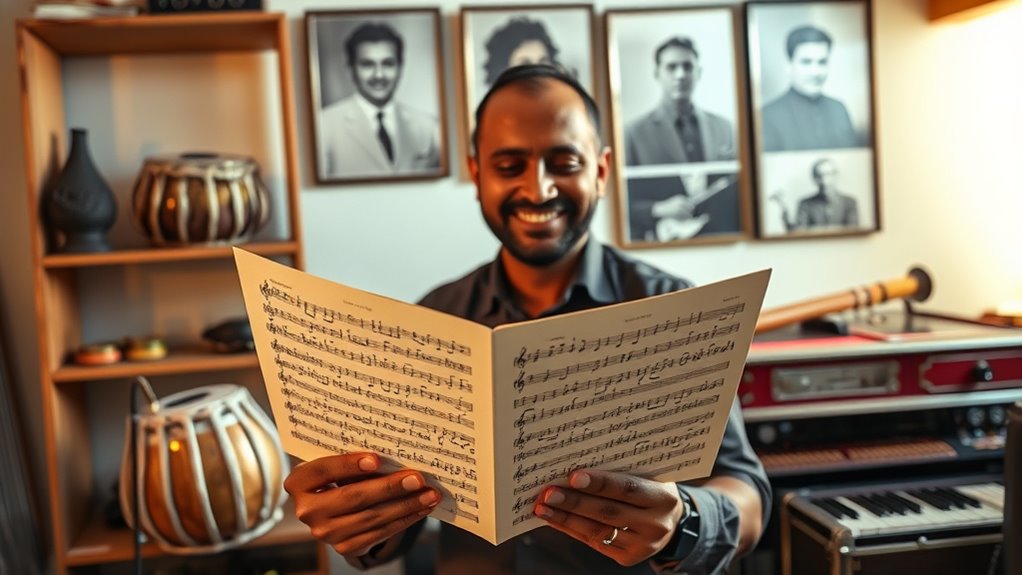
S.D. Burman’s music stands out for its folk roots and minimalist elegance. You can hear his mastery in blending rustic folk melodies with classical refinement, creating songs that feel both simple and profound. His use of folk elements evokes nostalgia and cultural pride, connecting deeply with listeners. Burman’s minimalist approach emphasizes clarity, allowing each note and rhythm to breathe, making his compositions timeless. Songs like “Yeh duniya agar mil bhi jaaye toh kya hai” showcase his ability to balance elegance with lively spirit. His style not only shaped Indian cinema but also inspired future generations of composers. You’ll find his melodies still resonate today, embodying a soulful simplicity that captures the true essence of Indian musical tradition. His innovative musical techniques continue to influence contemporary music composition. Additionally, his ability to fuse folk and classical styles contributed to the unique charm of his compositions, demonstrating his mastery of musical fusion and innovation. His work exemplifies how musical simplicity can create powerful emotional impacts that endure over time. Moreover, his approach to orchestration and arrangement helped elevate the emotional depth of his songs, setting a standard for musical storytelling.
O.P. Nayyar’s Rhythmic and Western-inspired Compositions
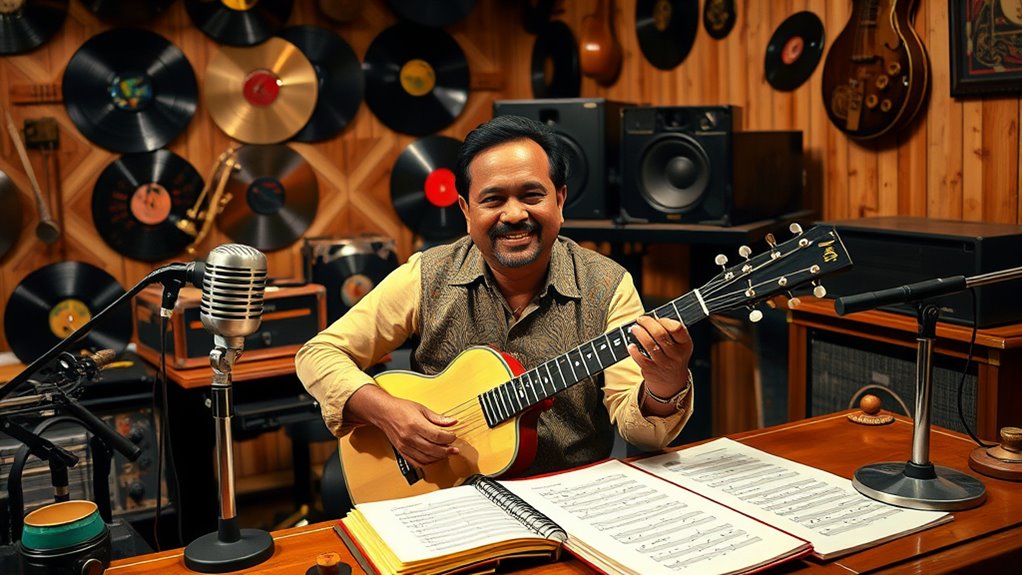
O.P. Nayyar’s rhythmic style is instantly recognizable. He integrated upbeat, catchy beats that made his songs lively and danceable. He combined traditional Indian drums with Western drum kits, creating a fresh, energetic sound. His repetitive, toe-tapping patterns set his compositions apart. Nayyar often used rhythmic cycles that broke from classical norms, adding modernity to Bollywood songs. He balanced melody with a strong rhythmic drive, appealing to 1950s and 1960s audiences. Additionally, his use of Western instruments like guitars and saxophones contributed to his distinctive sound.
Iconic Tracks That Define Each Music Director’s Legacy

Each music director has crafted iconic tracks that not only define their unique style but also leave a lasting impact on Bollywood’s musical landscape. These songs become timeless symbols of their artistry and influence. A.R. Rahman’s compositions like “Chaiyya Chaiyya” from *Dil Se* and the Oscar-winning scores for *Slumdog Millionaire* showcase his innovative fusion of melodies. Shankar-Jaikishan’s classics like “Mera Joota Hai Japani” from *Shree 420* evoke nostalgia and patriotic pride. R.D. Burman’s lively “Dum Maro Dum” from *Hare Rama Hare Krishna* captures the spirit of an era. Sachin Dev Burman’s romantic “Gaata Rahe Mera Dil” from *Guide* continues to touch hearts. Naushad’s soulful “Pyaar Kiya Toh Darna Kya” from *Mughal-e-Azam* embodies his mastery of classical music. Additionally, many of these composers integrated musical innovation into their work, pushing the boundaries of Bollywood music and influencing generations to come. These innovations often involved integrating traditional and modern musical elements to create a distinctive sound. Their ability to blend traditional elements with innovative techniques revolutionized the industry and set new standards for musical excellence. Moreover, their unique approaches to orchestration and arrangement have inspired countless composers and elevated Bollywood music to an art form.
Collaborations That Shaped Bollywood’s Musical Landscape
You can see how singer-composer partnerships like Lata Mangeshkar with Madan Mohan transformed Bollywood music by creating timeless melodies. These collaborations often led to landmark albums that changed the industry’s sound and set new standards. Exploring these partnerships reveals how they shaped the emotional and musical depth of Hindi cinema. Additionally, the musical collaboration between artists has historically been a key factor in producing iconic and memorable film soundtracks.
Iconic Singer-Composer Partnerships
Iconic singer-composer partnerships have played a pivotal role in shaping Bollywood’s musical landscape by creating timeless melodies that resonate across generations. These collaborations combine poetic lyrics with unforgettable tunes, leaving a lasting legacy. You can feel the magic when Kishore Kumar’s versatile voice blends seamlessly with R.D. Burman’s innovative compositions, or when Lata Mangeshkar’s melodious voice elevates Gulzar’s poetic lyrics. The synergy between Rafi and S.D. Burman produced classics that still evoke deep emotion, while Asha Bhosle and Pancham’s groundbreaking numbers broke musical boundaries. These partnerships didn’t just craft songs; they defined eras, setting standards for future collaborations.
- The soulful ghazals of Jagjit Singh and Gulzar that still touch hearts
- The poetic synergy of Shailendra and Shankar-Jaikishan shaping 50s-60s cinema
- The heartfelt lyrics of Majrooh Sultanpuri paired with Laxmikant-Pyarelal’s melodies
- Kishore Kumar and Kalyanji-Anandji’s chart-topping hits for Bollywood icons
Game-Changing Collaborative Albums
Game-changing collaborative albums have profoundly influenced Bollywood’s musical evolution by blending diverse genres and innovative ideas. The Ravi Shankar and George Harrison collaborations exemplify this, fusing Indian classical with Western rock and pop. Their albums, released between 1973 and 1996, made Indian music more accessible globally and inspired Bollywood to embrace international sounds. Modern collaborations, like Euphoria with Strings, Akriti Kakar, Dino James, and Kyna Sen, push boundaries by mixing indie, pop, rock, and rap, reflecting changing tastes. During Bollywood’s golden era, classical maestros like Ustad Amir Khan contributed to films like Baiju Bawra, setting new standards for classical and popular fusion. These collaborations broadened musical horizons, paving the way for innovative soundtracks and genre-defying projects that continue to shape Bollywood’s rich sonic landscape.
Awards and Recognitions Celebrating Musical Excellence
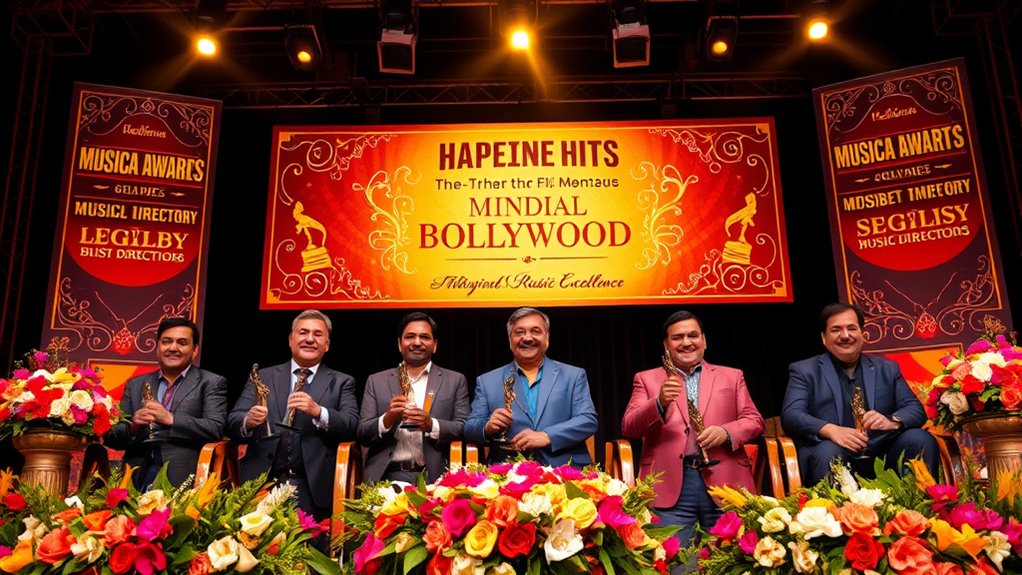
Recognizing musical excellence in Bollywood involves a host of prestigious awards and honors that celebrate the talent and innovation of composers. The National Film Award for Best Music Direction stands out, honoring outstanding work with the Silver Lotus Award. A.R. Rahman holds the record with seven awards, showcasing his enduring brilliance. Beyond national honors, music directors are celebrated through Filmfare, IIFA, Screen, and Zee Cine Awards, highlighting their impact across India and internationally. Recognitions extend to regional cinema, indie films, and global festivals, acknowledging diverse musical expressions. Personal honors like Padma Shri, lifetime achievement awards, and honorary doctorates further honor their contributions. These accolades not only recognize talent but also inspire generations to push creative boundaries.
- Feel the pride of national recognition for your favorite composer
- Witness the celebration of innovation across Indian cinema
- Celebrate lifetime achievement and cultural ambassador roles
- Experience the emotional power of awards that honor musical mastery
The Enduring Influence of These Legends on Modern Bollywood Music
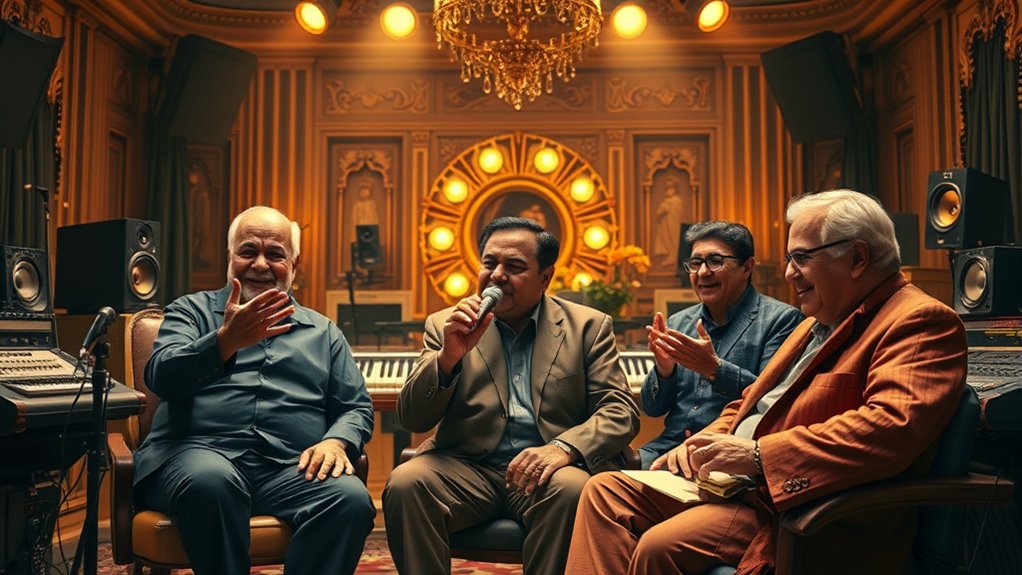
You can see how legendary music directors have shaped today’s Bollywood sound through their innovative techniques and genre-blending. Their work continues to inspire new composers, pushing boundaries and creating fresh, memorable music. This legacy of creativity and experimentation keeps Bollywood music vibrant and relevant in a changing world.
Innovative Composition Techniques
The innovative composition techniques pioneered by Bollywood legends continue to shape modern film music in profound ways. You can hear their influence in the way contemporary composers blend instruments, experiment with sounds, and push creative boundaries. They introduced synthesizers, electric guitars, and unconventional sources like glass bottles and typewriters, creating textures that stand out. Their signature fusion of Western rock and Indian melodies remains inspiring. Modern producers adopt these methods, using advanced sound engineering to craft layered, dynamic soundscapes. They also integrate classical rhythmic patterns, like tabla bols and ragas, into fresh compositions. Their experimentation with everyday objects and unique sound design continues to evoke strong emotions. These groundbreaking techniques have set a foundation for innovative, memorable Bollywood music that resonates today.
Fusion of Genres
The enduring influence of Bollywood legends is evident in how contemporary music seamlessly blends genres to create fresh, appealing sounds. You notice this fusion in tracks that combine Indian classical, folk, electronic, and Western styles. R.D. Burman pioneered blending Indian melodies with Western elements, inspiring today’s experimentation with genres like EDM and hip-hop. Modern composers, such as Shankar-Ehsaan-Loy, continue to push boundaries, mixing jazz, rock, and traditional sounds. This genre fusion broadens Bollywood’s global reach and appeals to diverse audiences. Here’s a snapshot of key influences:
| Pioneer | Style | Impact |
|---|---|---|
| R.D. Burman | Classical + Western | Iconic songs like “Tere Bina” |
| A.R. Rahman | Indian + Western orchestration | International acclaim |
| Amit Trivedi | Experimental | Genre-bending tracks |
| Shankar-Ehsaan-Loy | Fusion of styles | Modern versatility |
| Tech Advancements | Digital production | Broader reach |
Inspirational Legacy
Bollywood’s modern soundscape owes much to the enduring influence of legendary composers whose innovative approaches continue to inspire new generations. Their timeless melodies and groundbreaking techniques shape today’s music industry, motivating emerging artists and composers worldwide. You’ll find their influence reflected in global fusion styles, blending orchestral sounds and traditional elements. These legends’ songs are frequently remixed, covered, and featured in new films, keeping their legacy alive. Their pioneering studio work and use of technology set standards still followed today. Many contemporary composers openly cite these icons as primary inspirations, and institutions use their music as teaching tools. Their cultural impact endures through awards, international recognition, and nostalgic trends, ensuring their creative spirit continues to inspire new heights in Bollywood music.
- Their melodies are reinterpreted and celebrated across generations
- New artists pay homage through covers and tributes
- Modern production techniques trace back to their innovations
- Their influence is felt in awards, recognition, and cultural celebrations
How These Maestro’s Unique Styles Continue to Inspire New Generations
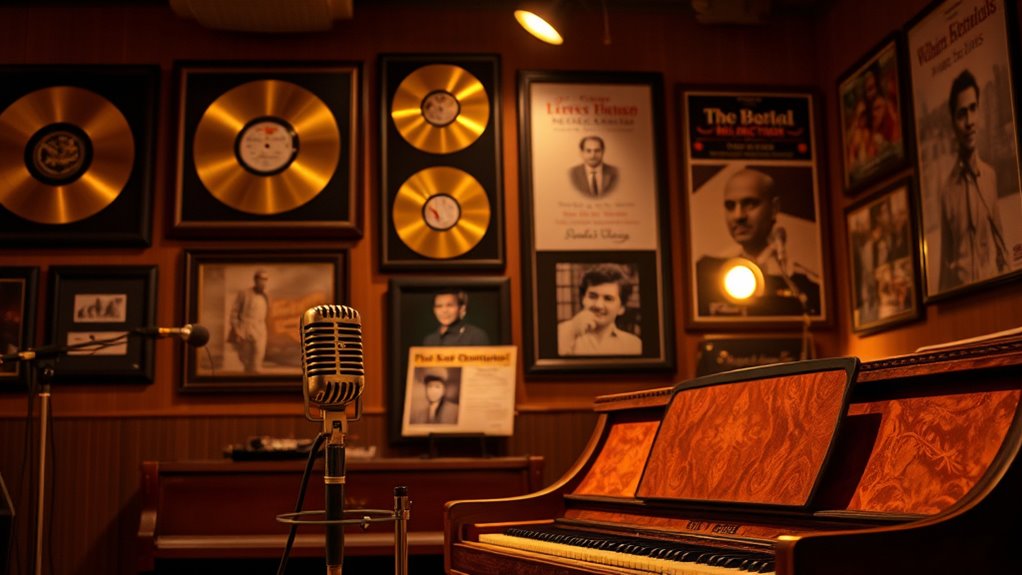
These maestros’ distinctive styles continue to shape the next generation of music directors by offering innovative approaches and a deep respect for tradition. A.R. Rahman’s fusion of classical and contemporary sounds encourages composers to blend diverse musical languages, inspiring cross-cultural experimentation. His pioneering work in independent music production and global collaborations set new standards for innovation. O.P. Nayyar’s rhythmic innovation and minimalism motivate young artists to explore unconventional instrumentation and energetic arrangements. Shankar-Jaikishan’s mastery of Indian classical and folk melodies reminds composers of the power of traditional motifs combined with sophisticated orchestration. Laxmikant-Pyarelal’s integration of ragas into mainstream cinema demonstrates how classical training can elevate popular music. These unique styles continue to inspire new talents to push boundaries, honor tradition, and craft timeless melodies that resonate across generations.
Frequently Asked Questions
Which Music Director Pioneered the Fusion of Indian Classical and World Music?
You’re asking who pioneered blending Indian classical with world music. A.R. Rahman stands out as the trailblazer, infusing Indian classical traditions with international styles. His innovative approach has not only transformed Bollywood but also gained global recognition. By seamlessly merging diverse musical influences, he created a unique sound that appeals worldwide. His work continues to inspire musicians and shape the future of fusion music, making him a true pioneer in this genre.
How Did R.D. Burman Influence Western Music Styles in Bollywood?
You see, R.D. Burman influenced Western music styles in Bollywood by blending genres like jazz, rock, and Latin into his compositions. He used Western orchestration techniques and electronic instruments, inspired by icons like The Beatles and Quincy Jones. This experimentation created a fusion sound that was both innovative and accessible, broadening Bollywood’s appeal globally. His approach transformed film music, inspiring future composers to embrace international trends while keeping Indian melodies intact.
What Orchestral Techniques Distinguished Shankar-Jaikishan’S Compositions?
You notice that Shankar-Jaikishan’s compositions stand out because they masterfully blend Western orchestral techniques with Indian classical elements. They often start with a prelude to set the mood and include diverse interludes featuring different instruments. Their use of layered orchestration, unconventional instruments like mandolin, and large-scale ensembles create rich textures. This innovative approach adds emotional depth and timeless appeal, shaping Bollywood music’s evolution and inspiring future composers.
In What Ways Did S.D. Burman Incorporate Folk Elements Into Bollywood Music?
You see, S.D. Burman incorporated folk elements into Bollywood music by weaving traditional melodies and instruments into his compositions. He drew from Bengali folk music, using instruments like sarangi and tabla to add authentic textures. This fusion made his songs relatable and timeless, influencing many others. His innovative blending of folk and classical sounds created a rich, Indian musical identity that continues to inspire musicians today.
Why Was O.P. Nayyar Known as a Trendsetter for Upbeat Bollywood Tunes?
Imagine you’re at a lively street festival in the 1950s—O.P. Nayyar’s music captures that energy perfectly. He’s known as a trendsetter because he introduced upbeat, vibrant tunes that broke from traditional Bollywood norms. You’d notice his innovative rhythmic patterns, fusion of Western and Indian sounds, and collaborations with singers like Asha Bhosle. His fresh, catchy melodies make you want to dance, setting new standards for lively, modern Hindi film music.
Conclusion
These legendary music directors have shaped Bollywood’s soundscape with their unique styles and timeless hits. Their innovations continue to inspire new artists and captivate audiences worldwide. Can you imagine Bollywood without their unforgettable melodies? Their legacy proves that true musical mastery transcends generations, reminding us that great music isn’t just heard—it’s felt deeply. So, next time you listen to a classic hit, remember the maestros behind the magic.



